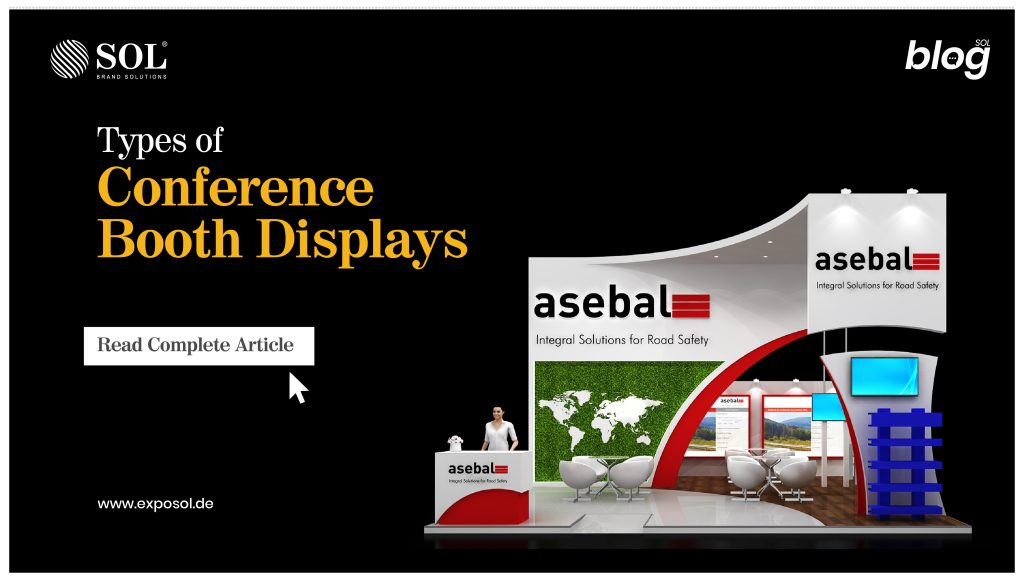Whether you are a first-time exhibitor or a seasoned one, with each passing year, as a company your exhibition goal is to out-do your last performance. This also means that you will at some point of time switch up your exhibiting location for a better one.
When that happens, the one thing that you need to keep in mind is that with a new location, the booth space and layout will also change. This means that you will have to choose a new type of exhibition stand.
Here are 5 common types of conference booth displays found in exhibition events.
- Perimeter Booth
A Perimeter Booth is a Linear Booth that faces the outer wall of the show venue instead of another display. All of the specifications for Linear Booths apply to Perimeter Booths, with the exception of the maximum rear wall height of twelve feet.
These are the booths in the conference centre that are backed up against a structural wall. They don’t have as much space as a luxury island or peninsula booth, but the height constraints for perimeter booths are often significantly higher than for centre booths, allowing you to reach and be seen from a greater distance. Furthermore, being against a wall or at the end of a big aisle typically draws people to your booth without them recognising it. They can see your booth in their peripheral view the entire time they’re walking down the aisle, whether they realise it or not.
In most cases, people will stroll along that path until they reach the finish, increasing the chances that they will engage the booth to learn more about your product.
Each booth type has its own set of advantages and disadvantages, so think about what you really want to accomplish during the event. Weigh your costs against your opportunities to see which booth has the best chance of achieving your aim. By analysing the cost-benefit analysis of an exhibit space, you may improve your chances of success regardless of the style that best suits your brand’s needs.
Linear or in-line booth
These are the most common booth packages available at exhibitions. In-line or linear booths are positioned in an aisle with booths on either side of their show, making it the most difficult to stand out from the other exhibitors. Companies can try to maximise exposure by choosing in-line booths near the event’s hot places, but you should also devote a substantial amount of effort to increasing foot traffic in front of your linear booth using digital means.
Peninsula Booth
The peninsula booths are set out along three aisles, with a booth backed up on the far side. You should expect a large increase in traffic and opportunities to engage with passing attendees due to the booth’s prominent location. Peninsulas often have greater room, and exhibitors take advantage of this by constructing multi-story structures for expo goers to traverse. They typically have three to four times the square footage of a regular booth, allowing your marketing team to let their imaginations run wild while designing the open area.With more freedom, you’ll have a better chance of standing out among the other exhibitors. Peninsula booths, like those on the island, will levy a premium.
Island Booth
These booths are the “creme de la creme” of them all. They are self-standing exhibits with aisles on all four sides, as the name implies. Island booths provide you a lot more freedom and options for decorating your large open space. Because you own that complete presence without the distraction of next-door adjacent exhibitors, this layout makes it easier to engage with attendees for longer periods of time. Consider collaborating on a co-marketing opportunity with a partner to divide the cost of an island booth and cut the cost in half. If you’re serious about establishing a line of company with a complimentary partner, this collaboration is also incredibly helpful. The obvious disadvantage of these types of booths is their cost, so if cost is a concern, islands may not be your first choice for exhibiting.
- Corner Booth
Exposure is a big part of how well your booth does at an event, and corner booths will provide you the most by being in two different lanes at the same time. By boosting the amount of face time your displays have with the passing audience, you can generate twice the amount of foot traffic and make the most of the area. This enhances the likelihood of attracting the attention of passers-by, as well as creating a more open and navigable environment where visitors will feel more at ease exploring the exhibit. However, these booths are more expensive, but depending on how important your company’s performance at the next expo show is, the extra cost may be justified.
These are some of the most common types of conference booth displays found in expo fairs. According to these, the booking spaces are made available to the exhibitors, who select the desired booth space and construct their expo booth.
As a company, it’s advisable that you pay attention to your exhibition goals before selecting a 3d exhibition stall design. This will help you understand what aspect of your expo fair booth design and display you want to highlight.








